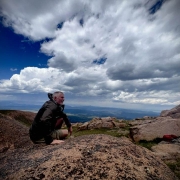Strategies for Breaking Up, Part 3 | Healthy Aging Series: Season 9, Episode 10
What Was the one Moment That Changed Your Life?
I tell my sons and granddaughters that they are here today because the Navy Recruiter had gone to lunch.
Let me explain.
I graduated from high school in 1974. Geez, I’m getting old, yay.
I went to work with my father and Jackson Engineering after high school. He was the vice president and recruited me.
I loved working with Jerry Neese. I loved everything about my father, and in all my life, I never had a cross word with him. I never had a cross word with my mother, unless you count the time she smacked my face. It was the summer of 1968 and Robert F. Kennedy had been assassinated. My mother was heartbroken and glued to our only little black-and-white TV. I wasn’t very sympathetic and wanted to watch something else, probably Star Trek. Mom refused to change the channel and I told her I was glad he was shot! She stood up and smacked me. I sat down and watched the news about JFK. At least that’s what I hope I did.
Going to work with my father was a no-brainer. I had a new 1974 Chevy Nova, new business-casual clothes, but I wasn’t there but a few weeks and the urge or desire to do something else slowly grew within me. It wasn’t a decision to leave, rather it was a decision to explore. There was a push and pull. The push was the thought of never leaving Southern Indiana, and the pull was all the people, places, and things in this big, beautiful, exciting world we live in. It was an urge that nothing seemed to soothe except the thought of leaving.
So, I decided to join the Navy. My older brother had joined the Navy. My dad was a Marine and served on a ship at the end of World War II. So, I took a lunch break and went down to the Civic Center overlooking the dingy Ohio River to visit the Navy recruiter. I can feel my heart rate increase thinking about that day in July, two weeks before my 18th birthday. The hall was lined with other recruiting offices. Besides the Navy recruiter there were office for the Air Force, Army, Marines, and Coast Guard. When I arrived at the Navy Recruiters office, there was one of those “be back at” clocks that showed 1 pm. I wandered around the hallway for a second or two and the Air Force recruiter saw me looking a little frustrated and invited me into his office. With Staff Sergeant Burke’s help I enlisted in the Air Force.
In that moment, my life was changed. It changed because I went for training in San Antonio Texas instead of Michigan. It changed because I went to my first assignment, which was Rickenbacker Air Force Base in Columbus, Ohio, where I would meet my sons’ mother and my granddaughters’ grandmother. My sons and by extension my granddaughters are here today because the Navy recruiter had gone to lunch.
I can come up with a half a dozen other moments that have changed my life. Some educational. Some made about employment. Some made on basis of relocating to a new state.
What about you? Think about those life-changing moments that you’ve had.
Gemma Dale and Her Moment of Change
This brings me to the fourth Obesity Memoir that I’ve read this season. “Memoirs of a Former Fatty: How one Girl Went from Fat to Fit,” by Gemma Dale
Gemma went from a size 22 to size 8, lost 80 pounds and ended her for your journey of weight loss with a half marathon.
Everything I’ve written about this season on how to break up with the food is in her book. There is a push and a pull in her life to break up with food. The push was the shame, the knee problems, poor health, gall stones, and the problem with walking stairs. The pull was as she said, “I lost weight and gained a new life.“ She writes that she doesn’t have a magazine, perfect body, but learning to love exercise, “There is power there is freedom, in your feet.” The pull was being strong.
“Somewhere along the way, in the middle of 2014, something shifted. I’d lost about four and a half stone by this point. And this is when it stopped being just about a number on the scales and started being about how strong I was; how strong I could possibly be. It was about being toned. And what my body might be capable of.”
Gemma writes that you must change the way you think about yourself and about food. If you want to change the way you act. That change, she writes, starts with simply thinking about making a change. “You’ve got to have a dream.”
Where have you read this?
“Fitness,” she writes, “is as much a mental process as a physical one.”
Gemma doesn’t word it exactly the way that I worded it, but changing your eating habits, and your health often mean breaking up with food. It means, “breaking old habits, and making newer, healthier ones.”
Everything changed about her life. Her friendships. Her family relationships. Where she hung out, and who she hung out with.
And she has some wonderful slogans in her book. I love slogans.
“If you want to do something badly enough, you will find a way, if not, you will find an excuse.”
And her racing slogan is “Better last than did not finish, which is better than did not start.”
How did she lose weight? This was a very common theme in the other obesity memoirs that I’ve read. She simply ate less and moved more. There is something very simple about the way these writers lost a large amount of weight. They simply ate less and began moving and exercising.
She talks about the diet industry or what some call, The Fitness-Industrial Complex, and it’s one purpose to sell a fantasy. A fallacy, she explains. She calls what they sell as garbage.
“There is no quick fix. No matter what the latest guru or carefully edited celebrity yells at you.“
And there’s more in her book. It’s an easy read. But what about that moment, that life-changing moment, that changed her forever. I’ll share a lengthy section of her book in her words.
“Most overweight people who go on to lose a lot of weight, have generally had a moment. A moment in which something happens, something shifts and changes, and they finally decide to do something about it.
I had a few moments along the way. Several false beginnings. But there was one moment that moved me from vague mutterings and half-hearted promises, all of which had historically led to not very much at all, to actual action with tangible results.
My moment was New Year’s Eve, 2011. I was at a black-tie dinner at my dad’s golf club. Already significantly overweight, with the Christmas quality street factored in, I was bigger than ever. My long, black evening dress was straining at the seams. A pair of spanks was doing its best to keep everything in place but failing to deliver. I felt, and probably looked, like an overstuffed sausage. My ankles were agony because of all the excess weight pushing down on them. There would be no dancing for me. Just an attempt to hide as much of my bulk as possible underneath the table and my giant wrap. During the evening, I went to the lady’s room. I sat in the cubicle and had myself a little cry. A pity party all by myself. And then that moment I decided. Something was going to change for definite this time. It would be no more false promises.”
She ends this section by writing, “The journey of weight loss is really a journey to a whole new life.”
I thought of my life as I read this obesity memoir.
I still need to grow. I have things that need to change. I’ll take some time this weekend in the Smoky Mountains doing a solo backpacking trip. No talking, just listening to that still small voice.
Open to change, wanting to change and expecting another moment of change in my life.
To read more entries in the Healthy Aging series, click here.
To purchase Memoirs of a Former Fatty: How one Girl Went from Fat to Fit, by Gemma Dale, click here.





